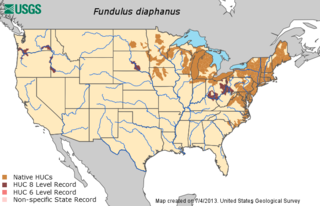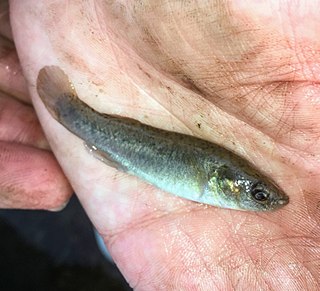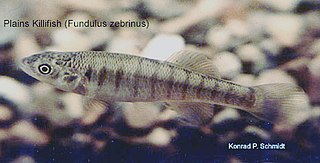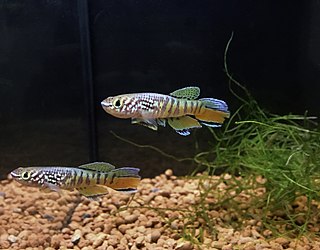
The mummichog is a small killifish found along the Atlantic coast of the United States and Canada. Also known as Atlantic killifish, mummies, gudgeons, and mud minnows, these fish inhabit brackish and coastal waters including estuaries and salt marshes. The species is noted for its hardiness and ability to tolerate highly variable salinity, temperature fluctuations from 6 to 35 °C, very low oxygen levels, and heavily polluted ecosystems. As a result, the mummichog is a popular research subject in embryological, physiological, and toxicological studies. It is also the first fish ever sent to space, aboard Skylab in 1973.

Fundulus is a genus of ray-finned fishes in the superfamily Funduloidea, family Fundulidae. It belongs to the order of toothcarps (Cyprinodontiformes), and therein the large suborder Cyprinodontoidei. Most of its closest living relatives are egg-laying, with the notable exception of the splitfin livebearers (Goodeidae).

Fundulidae is the family of topminnows and North American killifishes.

The California killifish is a type of killifish (Fundulidae) found along the coast of southern California and Baja California.

The banded killifish is a North American species of temperate freshwater killifish belonging to the genus Fundulus of the family Fundulidae. Its natural geographic range extends from Newfoundland to South Carolina, and west to Minnesota, including the Great Lakes drainages. This species is the only freshwater killifish found in the northeastern United States. While it is primarily a freshwater species, it can occasionally be found in brackish water.

The blackstripe topminnow, Fundulus notatus, is a small freshwater fish in the family Fundulidae, found in central North America.

The Waccamaw killifish is a species of fish in the family Fundulidae. It is endemic to Lake Waccamaw, a lake in North Carolina, United States, and its tributaries.

The saltmarsh topminnow is a species of killifish for the family Fundulidae. It occurs in the coastal wetlands of the Gulf of Mexico in the United States.
The Bermuda killifish is a small fish which is endemic to the islands of Bermuda in the western Atlantic Ocean. It belongs to the genus Fundulus in the killifish and topminnow family, Fundulidae.

The striped killifish, also called the striped mummichog, is a North American species of fundulid killifish. It lives in salt and brackish waters in shallow coastal regions from New Hampshire to Florida, and in the northern Gulf of Mexico.

The lined topminnow is a small fish in the genus Fundulus which is found in swamps and backwaters from southern Virginia to Lake Okeechobee.
The blackspotted topminnow, Fundulus olivaceus, is a species of fish in the family Fundulidae: the topminnows and North American killifishes. It is native to the south-central United States, where it is known from the drainages of the Mississippi River from Illinois to the Gulf of Mexico and as far west as Galveston Bay.
The Baja California killifish is a killifish in the family Fundulidae. It is native to the Baja California Peninsula region of northwestern Mexico. This fish was described by L.L. Vaillant in 1894 with the type locality given as San Ignacio de Caracamande in central Baja California.

The Gulf killifish is one of the largest members of the genus Fundulus; it is capable of growing up to 7 inches (18 cm) in length, whereas the majority of other Fundulus reach a maximum length of 4 inches (10 cm). Therefore, F. grandis is among the largest minnows preyed upon by many sport fish, such as flounder, speckled trout, and red drum. Fundulus derives from the Latin meaning "bottom," and grandis means "large". The Gulf killifish is native to the Gulf of Mexico from Texas to Florida and the eastern coast of Florida and the Caribbean Sea in the Atlantic Ocean. Threats to the survival of the Gulf killifish include extreme changes in salinity, changes in temperatures, and toxic events such as the hypoxic dead zone in Louisiana and the Deepwater Horizon oil spill. The Gulf killifish is currently being used to test the effects of oil and oil dispersants on the physiology of marine species affected by these substances. This is significant to conservation biology, because with the continued extraction of oil and other natural resources from North American waters, it has become increasingly important to understand the risks and consequences in worst-case scenarios, such as the Deepwater Horizon oil spill, and the lasting effects on the marine ecosystem.

The bayou killifish or bayou topminnow is a topminnow-like fish that thrives primarily in the shallow waters off the shores of the Americas, as well as fresh and brackish waters. Feeding off of small vertebrates and invertebrates, this fish displays reproduction techniques unique to its species.

Fundulus zebrinus is a species of fish in the Fundulidae known by the common name plains killifish. It is native to North America, where it is distributed throughout the Mississippi River, Colorado River, and Rio Grande drainages, and other river systems; many of its occurrences represent introduced populations.

Fundulus nottii, the bayou topminnow or southern starhead topminnow, is a fish of the family Fundulidae found in the southeastern United States.

Fundulus luciae, the spotfin killifish, is a member of the genus Fundulus. This hardy fish is notable for spending its entire life in sporadically flooded salt marsh habitat, sheltering in shallow pools, puddles, and small tidal rivulets. It closely resembles the mummichog in shape and coloration, but the two species can be distinguished by dorsal fin ray count: 8–9 in the spotfin versus 11–12 in the mummichog. Additionally, the dorsal fin of F. luciae originates farther back, and slightly behind the anal fin origin; in the mummichog, the dorsal fin begins anteriorly to the anal fin origin. The spotfin killifish is named for the pronounced ocellus found on the posterior dorsal fin of adult males. It is a small fish, seldom attaining 50 millimetres (2.0 in) in total length. Its distribution extends along the U.S. east coast from Massachusetts to Georgia.

The Seminole killifish is a fish of the genus Fundulus, endemic to the U.S. state of Florida.

Fundulopanchax sjostedti, the blue gularis, golden pheasant gularis or red aphyosemion, is a species of toothcarp endemic to the Niger delta. It is only found in Nigeria and Cameroon. It is named after the Swedish naturalist Bror Yngve Sjöstedt (1866–1948) who collected the type specimen close to a waterfall by the Ndian River, in the Ndian department in Cameroon's Southwest Region.

















